Manually prepared with minimum ingredients, this Chinese homemade noodle recipe shows you a traditional method to make noodles from scratch.
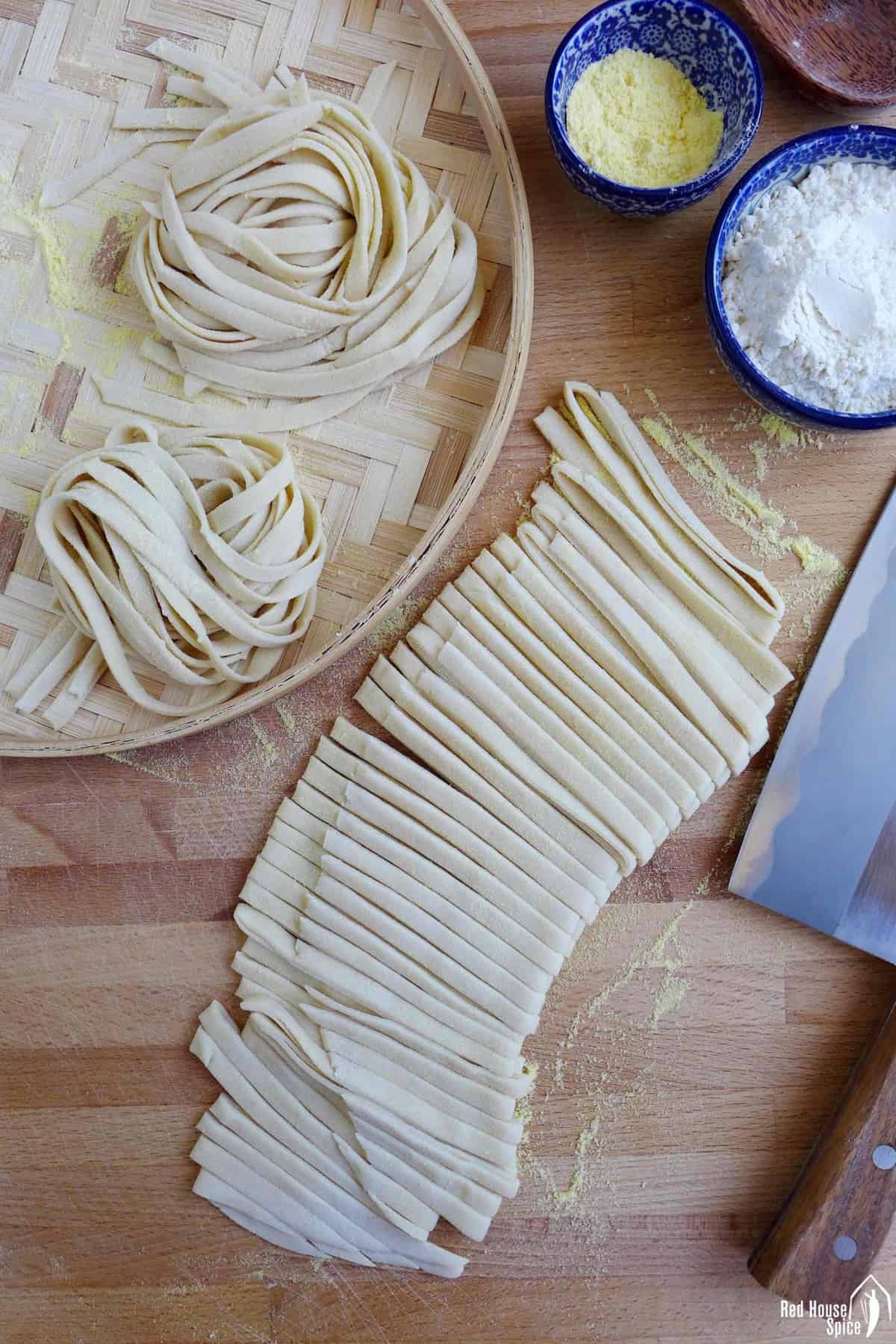
Although dried noodles are easily accessible, nothing can beat the taste and texture of fresh noodles. Agree? Today I’d like to share my mum’s easy recipe for homemade noodles “Shou Gan Mian (手擀面)” which literally means “hand-rolled noodles”.
Like hand-pulled noodles that I learnt from my parents, this noodle-making process is also totally manual with very basic ingredients. No stand mixer or noodle/pasta maker required. Flour, water, salt, a rolling pin and a knife are all that you need (It’s vegan friendly too).
If you enjoy working with dough and appreciate real food prepared with traditional methods, read on to discover how they’re made!
The general workflow
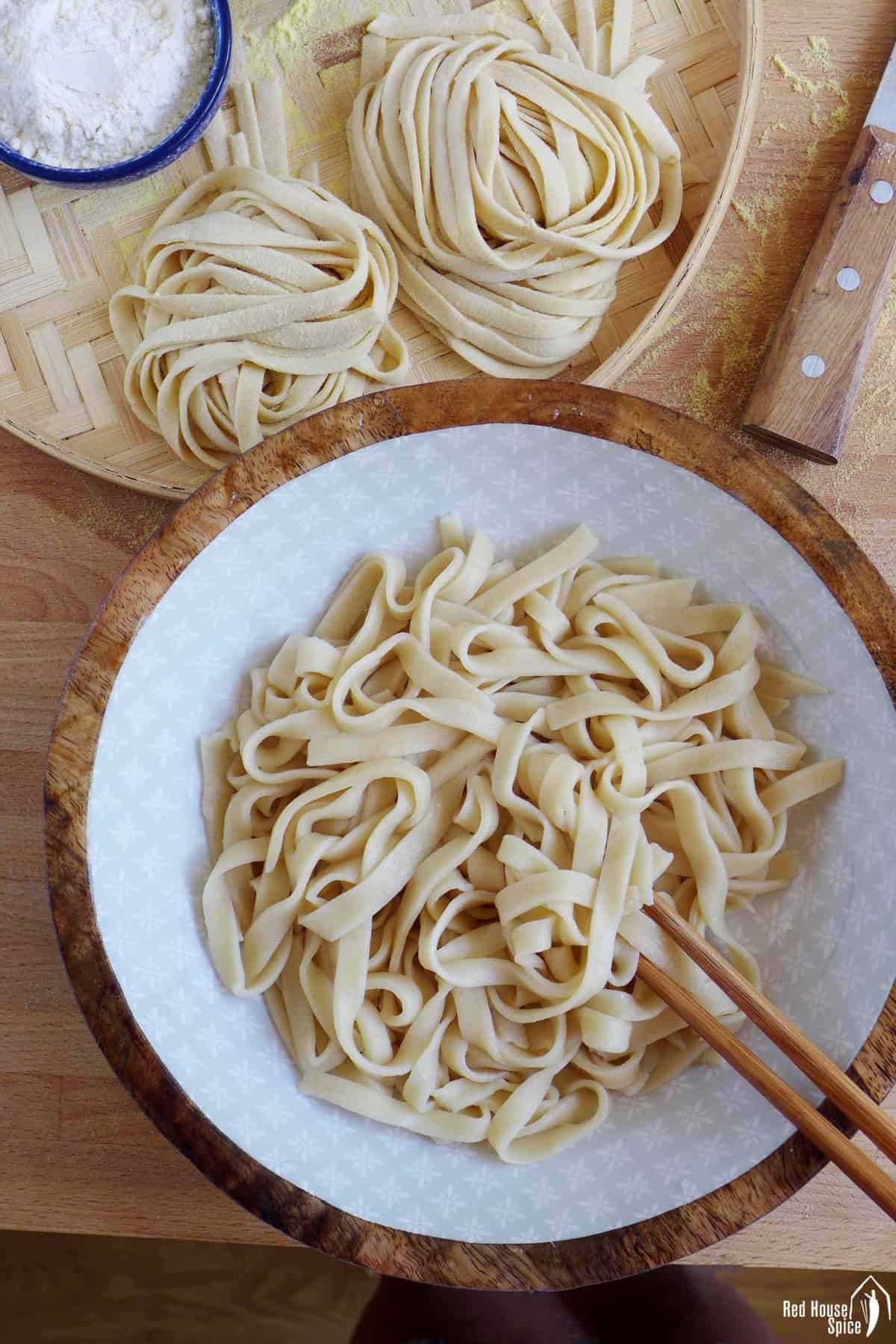
Before I explain each step in detail, here is the summary of the process. It takes 40-45 mins from start to finish (including the passive resting time).
- Combine flour, water and salt to form a dough then rest for half an hour.
- Flatten the dough into a thin sheet with a rolling pin.
- Fold the sheet then cut into narrow strips. Unfold and loosen the noodles.
- Cook the noodles in boiling water.
Step 1: Make the dough
You only need three basic ingredients: flour, water and salt.
What type of flour
All-purpose flour (aka plain flour) is the most accessible type and it works perfectly for homemade noodles. Please feel free to use bread flour which has a higher gluten content resulting in a more elastic texture.
🛎 NB: Cake flour, wholemeal flour, gluten-free flour and self-rising flour are not suitable for this recipe.
The flour-water ratio
For every 250g of all-purpose flour, you’d need about 115g water (at room temperature).
You may need to make slight adjustments based on the brand/type of your flour. Bread flour has a higher water absorption capacity thus needs a little more water.
The finished dough should be quite firm to touch but not at all crumbly. It has a lower hydration than hand-pulled noodles so when you roll it out it won’t be too sticky. Compared to the dough for machine-made noodles, its hydration level is higher so that it’s not too firm/dry to be flattened manually.
🛎NB: For best accuracy, measure the weight of flour and water with a scale. If using cups, here is how to convert:
- All-purpose flour: 250g equals about 2 cups (The flour needs to be sifted before spooning into the cup then levelled with a knife).
- Water: 115g equals about ½ cup
Add a little salt
The addition of salt helps to tighten the gluten network. Therefore the dough becomes more elastic and the cooked noodles have a more springy texture.
Make the dough manually
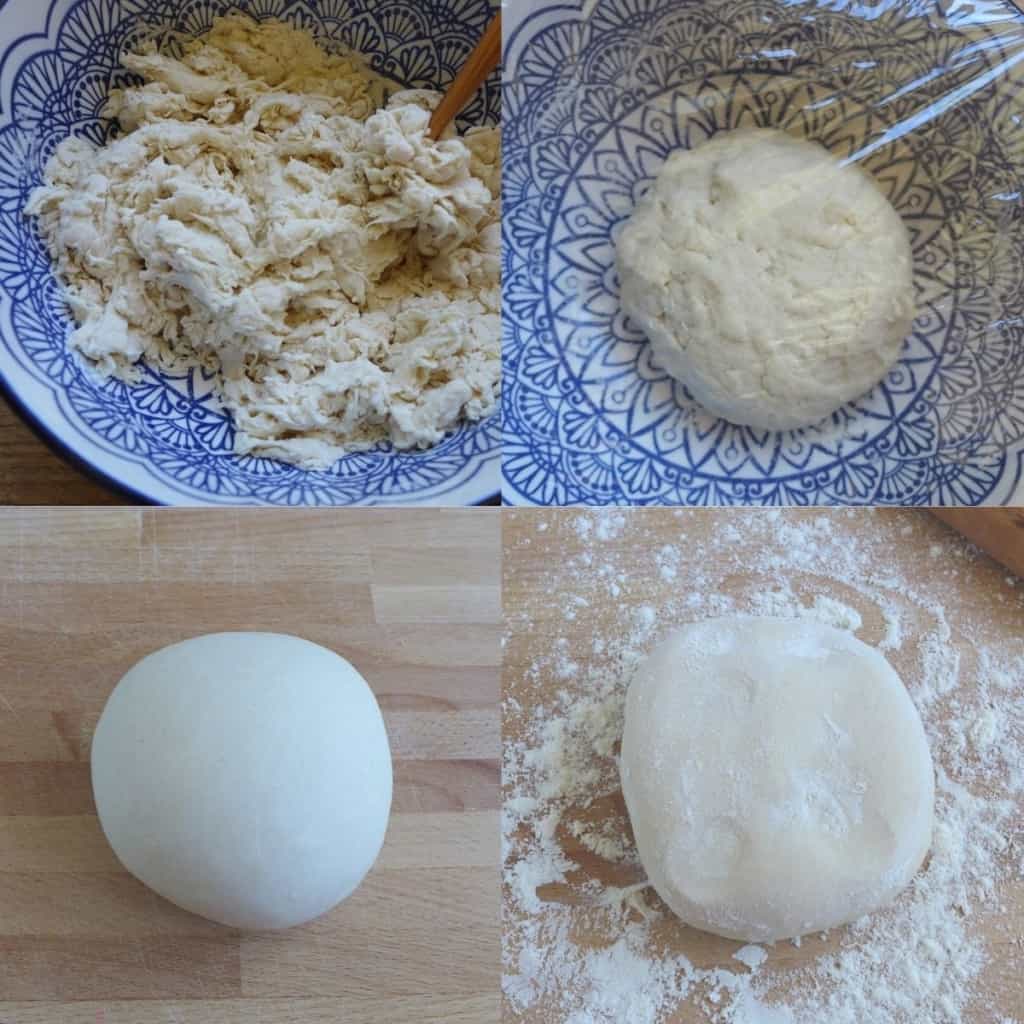
- Put flour and water into a large bowl then pour in water gradually while stirring the flour to evenly distribute the liquid.
- Combine the flour into a dough ball. It doesn’t need to be smooth at this stage. Cover then leave to rest for 30 mins.
- Knead again for about 3 mins. It will become smooth very easily.
If using a stand mixer with a dough hook, mix and knead on low speed for about 8 mins. Rest for 30 mins then go straight to the next step.
🛎 NB: I don’t recommend you rest the dough for longer than 1 hour as it will become softer and softer over time. A less firm dough may be easier to roll out but it sticks easily. Also, the cooked noodles tend to be on the soft side.
Step 2: Flatten the dough
The next step is to flatten the dough with a rolling pin into a thin sheet. In all honesty, it can be a tricky process if you’re not used to working with dough, or not experienced using a rolling pin. But don’t be intimidated by my statement. I have a few tricks to make it easier!
What type of rolling pin
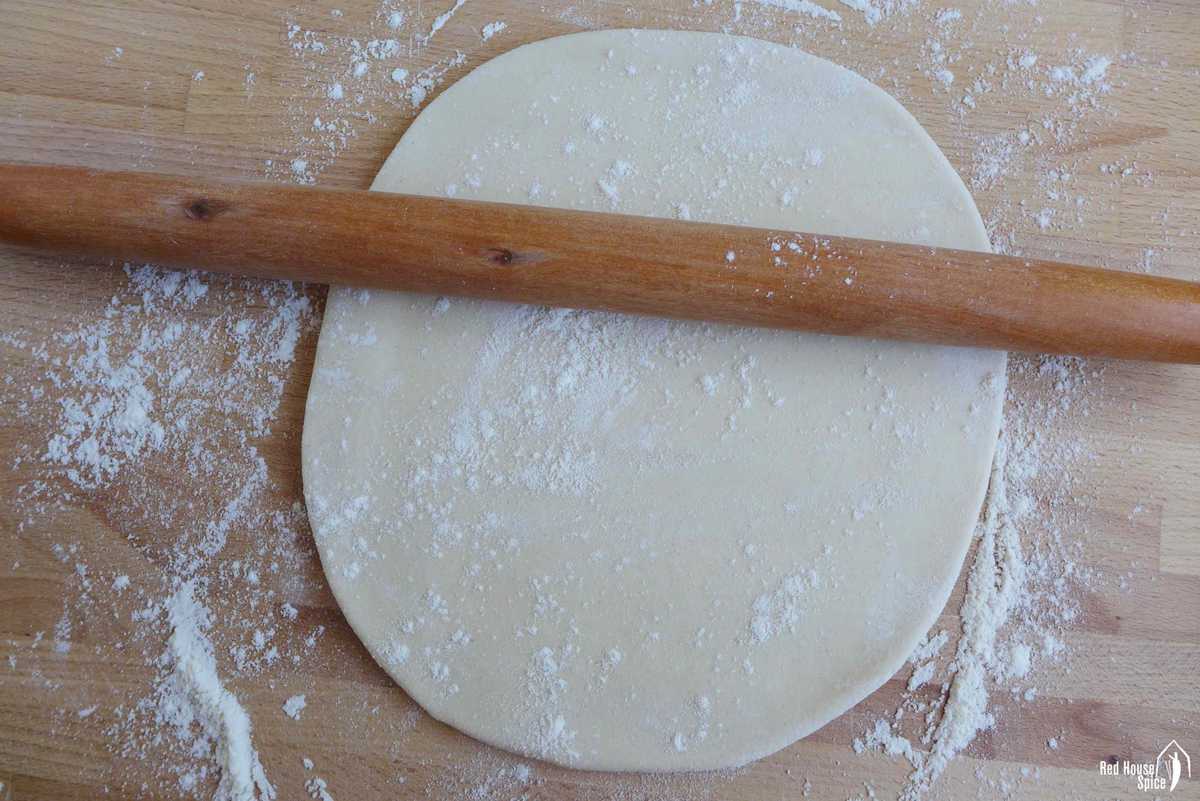
I use an all-purpose Chinese rolling pin which is slightly tapered. It measures 40cm (16 inches) long and about 3 cm (1 inch) in diameter (I use it for dumpling wrappers too). You may also use a pastry rolling pin with handles or other types as long as they’re not too short in length.
How to roll the dough
Place the dough over a large chopping board or directly over the kitchen worktop. Roll the dough from the centre outwards. Turn and flip as often as necessary to achieve an even thickness.
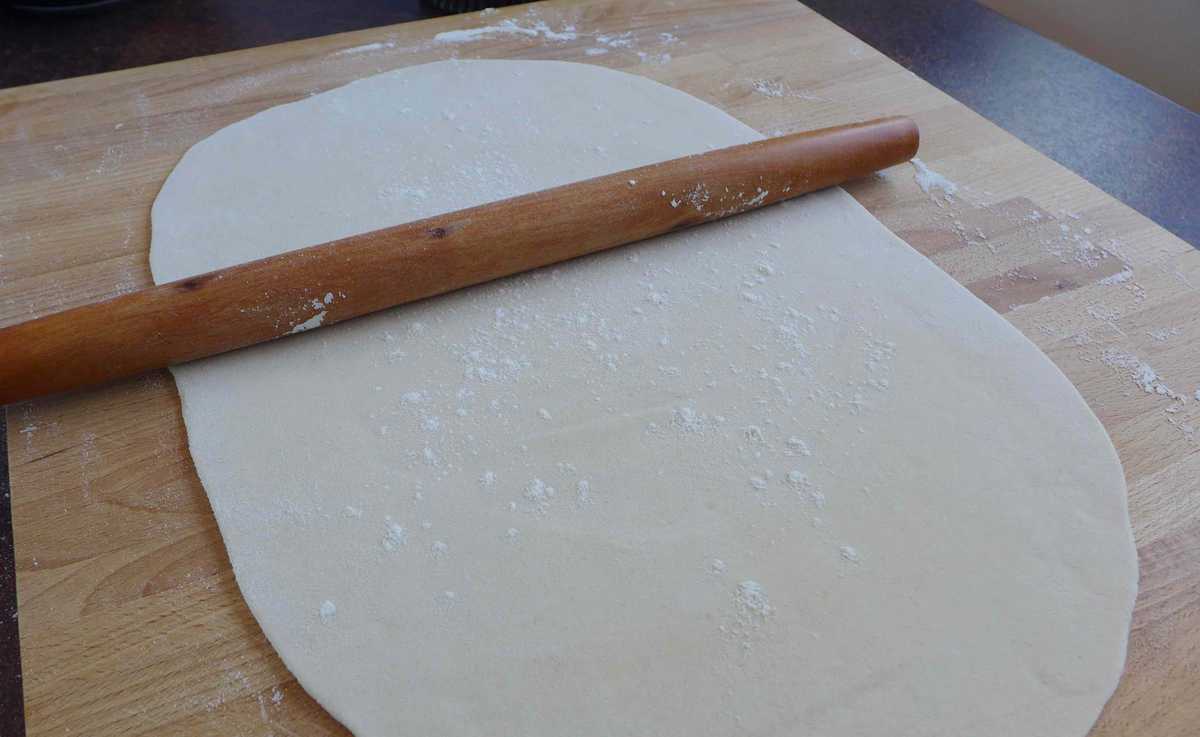
Remember to dust the dough and the work surface with flour frequently. This will prevent sticking thus making rolling much easier.
If you find it challenging, try dividing the dough into two pieces and work on one at a time. With practice, you’ll be able to roll a bigger batch.
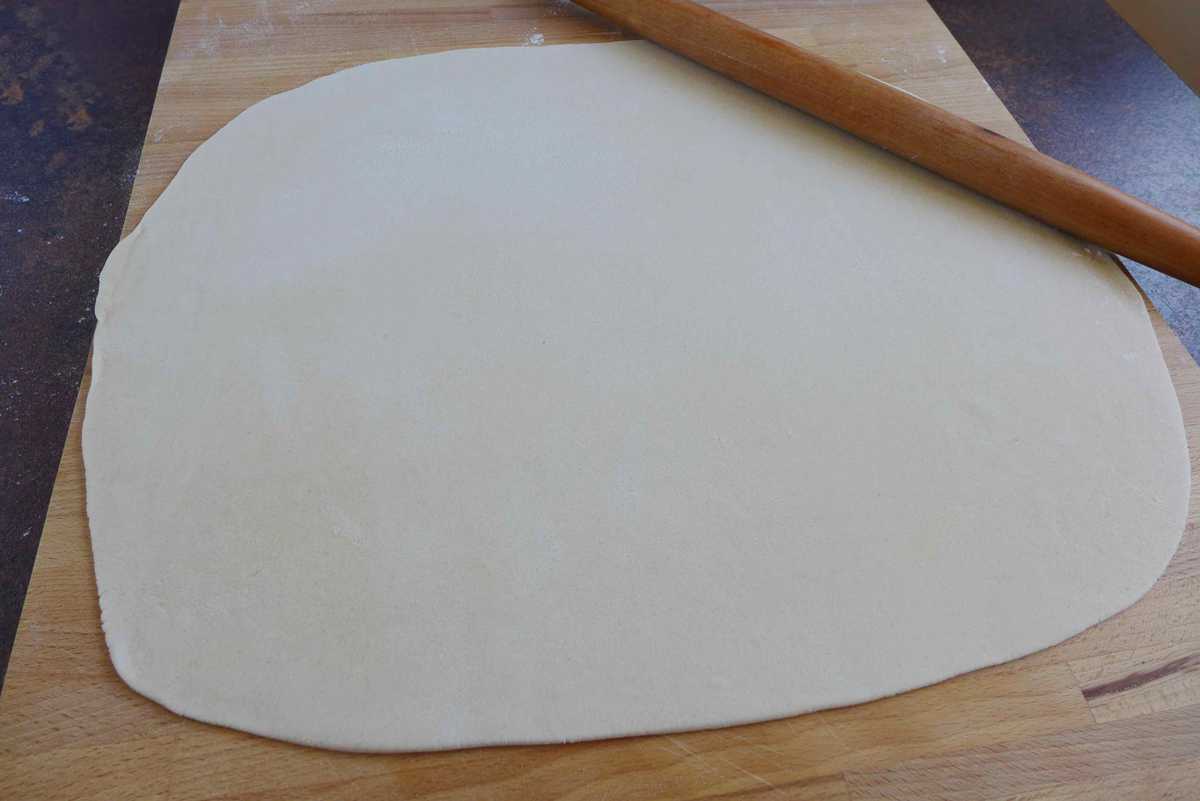
The thickness of the dough sheet depends on your rolling skill and your preference. Around 2 mm (⅛ inch) would be a good choice. Please bear in mind that the noodles will expand after cooking.
Step 3: cut the noodles
Fold the dough sheet into several layers then cut with a knife into thin strips. During this process, the dough tends to stick more easily (between layers and around the cut side) making separating the noodle strands more challenging.
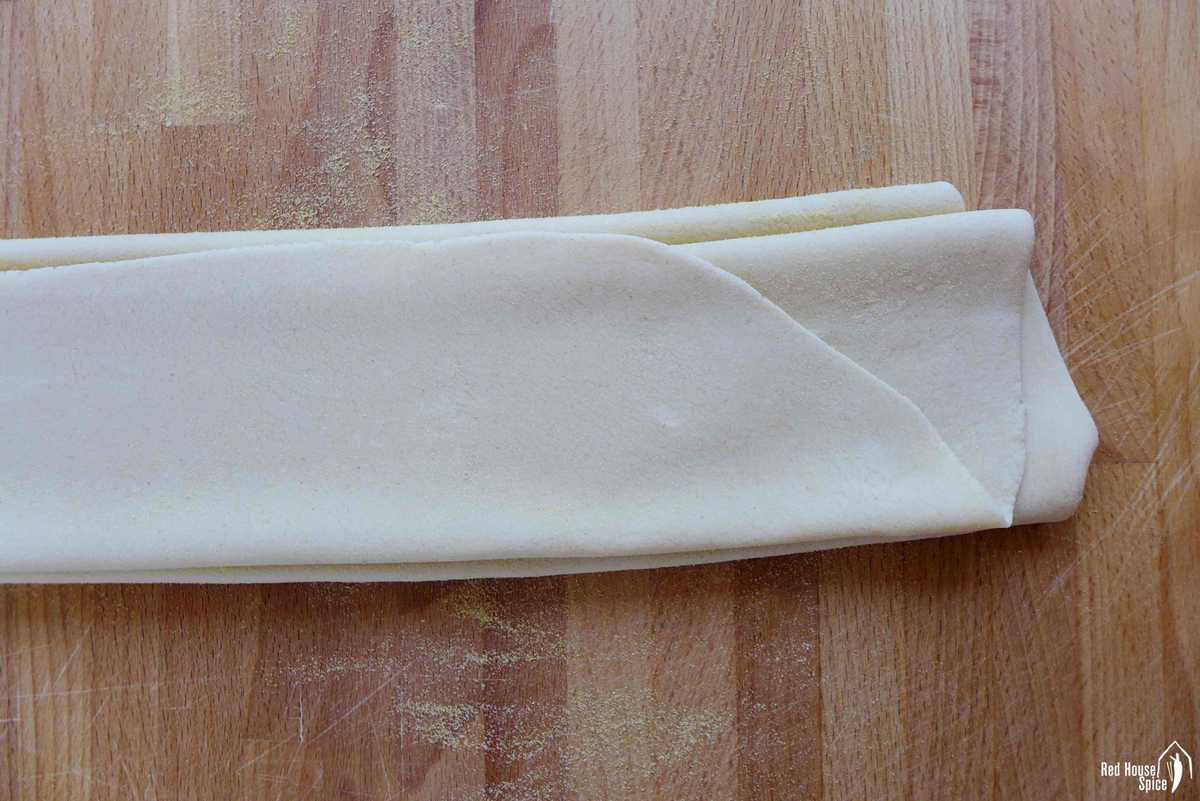
Here is the solution: Before folding and cutting, sprinkle cornmeal (or semolina) underneath and over the dough sheet. Having a more coarse consistency than flour, it’s much more effective for preventing sticking.
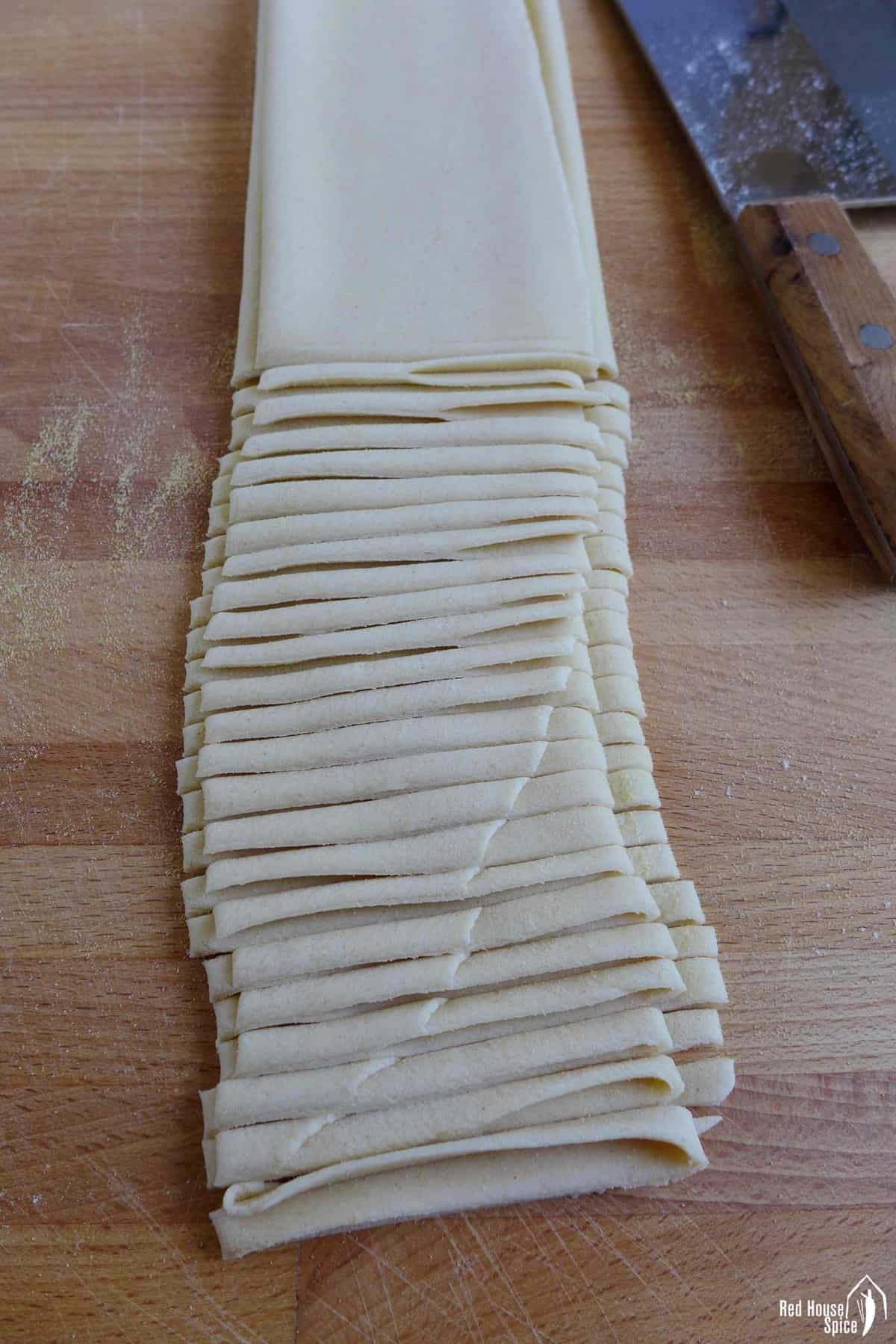
After cutting, gently loosen the noodles and sprinkle more cornmeal over if necessary.
🛎 A tip on cutting: use a sharp knife with a long blade (Chinese cleave works very well). Cut each strip fast without hesitation. Press the knife downwards to cut through instead of moving back and forward like using a saw.
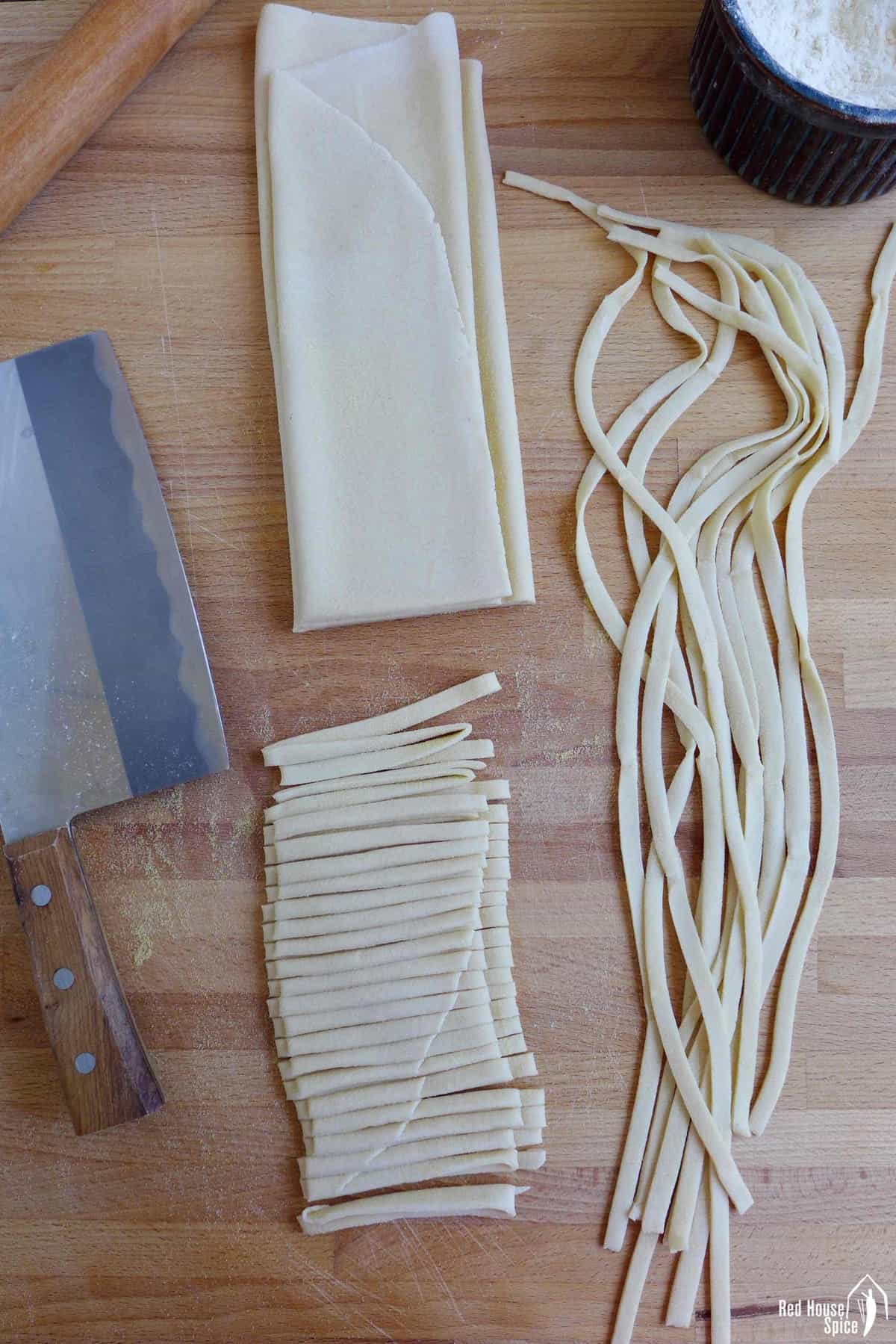
Step 4: Cook the noodles
It takes a very short time to cook homemade noodles.
- Bring a large pot of water to a full boil then add the noodles. Once it boils again, pour in about 120ml (½ cup) cold water.
- Cook for a further 1-2 mins. Taste a strand to check the doneness as the time required depends on the size of your noodles.
- Rinse the noodles briefly under running water to remove excess starch then drain well.
Serve the noodles
There are many delicious ways to serve homemade noodles. The meal I cook the most often is Chinese Tomato & Egg Noodle Soup (see image below). These flat noodles soak up the tasty broth very well!
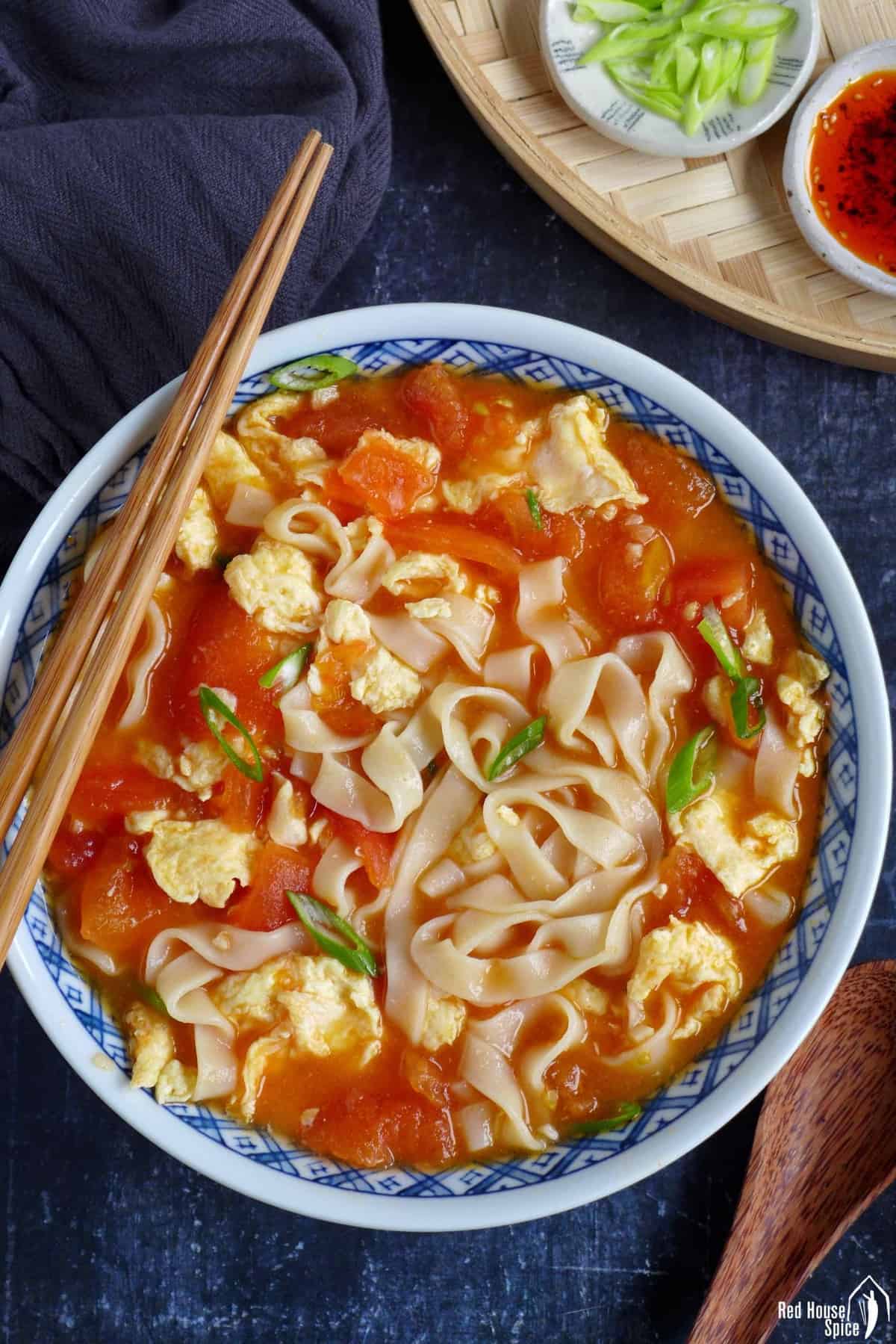
Here are a few more examples:
Store the noodles
If you make a big batch and have leftover uncooked noodles, freeze them immediately. Lay in single portions over a tray and put into the freezer. Once completely frozen, transfer to an airtight bag or container.
Follow the same instructions to cook without defrosting.
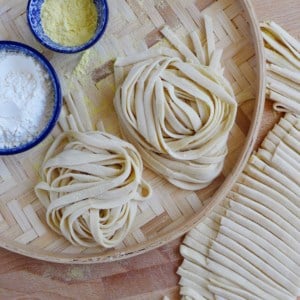
Easy Homemade Noodles (No Machine Required)
Ingredients
- 250 g all-purpose flour, or bread flour - plus extra for dusting
- ¼ teaspoon salt
- 115 g water - see note 1
- 1 tablespoon cornmeal or semolina - for dusting (optional), see note 2
Instructions
Make the dough
- In a large bowl, mix flour and salt. Add water gradually while stirring the flour constantly to evenly distribute the liquid.
- Combine with your hand into a rough-looking dough. Cover then leave to rest for 30 mins.
- Knead the dough for about 3 mins until it becomes very smooth.
Flatten the dough
- With a rolling pin, gradually flatten the dough into a sheet about 2mm thick. During this process, flip and turn the dough as often as necessary to achieve an even thickness. Also, remember to dust the surface and the dough with flour to prevent sticking.
Cut the noodles
- Once the dough is rolled to your desired thickness, spread cornmeal over and underneath. Then fold the dough sheet into a band of 4-5 layers. Use a sharp, dry knife to cut it into thin strips.
- Gently unfold and loosen the noodles with your hands.
Cook the noodles
- Bring a large pot of water to a full boil. Add the noodles. Cook over high heat. Once the water boils again, pour in 120ml/½ cup cold water.
- Cook the noodles for a further 1-2 mins (Taste a bit to check the doneness as the time required depends on the size of your noodles).
- Rinse the noodles briefly under running water to remove excess starch then drain well. Serve in soup or with sauce and toppings.
Store the noodles
- You may increase the ingredient quantity proportionally and make a bigger batch. It’s best to freeze uncooked noodles right after they’re cut and loosened.
- Sprinkle extra cornmeal to prevent sticking and divide them into single portions. Place them in a single layer onto a tray. Store in the freezer. Once completely frozen, transfer the noodles into an air-tight bag/container.
- Cook the usual way without defrosting.
NOTES
NUTRITION
NUTRITION DISCLOSURE: Nutritional information on this website is provided as a courtesy to readers. It should be considered estimates. Please use your own brand nutritional values or your preferred nutrition calculator to double check against our estimates.


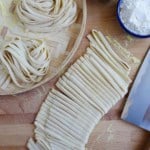
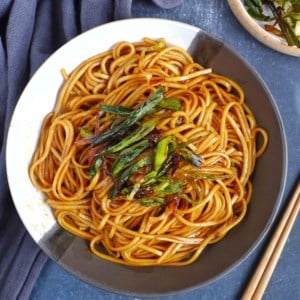



Love this website! So many amazing, authentic Chinese dishes 🙂
Could you please add a guide/ recipe to Longevity Noodles?
I would really appreciate that!
Thank you!
Thank you for your appreciation Sarah! Yes, I’ll add Longevity Noodles to my to-write list.
Great recipe, I usually alter proportions with recipe’s but with your one, I didnt have to which was great. I used them in a sticky chicken and noodle stir fry. Turned out amazing.
Thank you Alexander for trying out my recipe and sharing your feedback!
Very very good
Can the noodles be left in open air for a few hours until they are cooked?
You could. But you’ll need to make sure to coat the noodles very well with cornmeal to prevent sticking. If possible, store them in the freezer during these hours and boil as usual.
Such an easy to follow recipe which came out fantastic! I used 1/3 strong white flour, 2/3 all purpose flour. Noodles came out wonderfully with great texture. Thank you!
Homemade noodles are so tasty and satisfying, right? Glad my recipe worked well for you.
Can I put in an egg, and reduce the amount of water? Thanks!
Yes Agnes, you can replace part of the water with an egg. You may need to adjust the liquid volume slightly. Happy cooking!